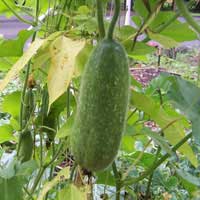 Full List of Fruits
Full List of Fruits  Wax Gourd
Wax GourdWax Gourd
Scientific name - Benincasa hispida
Wax gourd also known as white gourd is commonly identified with the name winter melon. It is a plant grown mainly for its large fruit, as it gets mature they are consumed as a vegetable. Nebulous when young, the fruit has a chunky white flesh which is sweet to taste. The best part about wax gourd is that it provides a long shelf life and by ripeness, the fruit loses its hair and develops a waxy coat, thereby giving rise to the name wax gourd. Even though the fruit is referred to as a “melon”, the fully grown crop is not that sweet to taste and as a matter of fact the melon may grow as large as 80 cm in length.
![]() Nutritional Value of Wax Gourd
Nutritional Value of Wax Gourd
| Nutritional value per 100 g (3.5 oz) | |
|---|---|
| Energy | 54 kJ (13 kcal) |
| Carbohydrates | 3 g |
| Dietary fiber | 2.9 g |
| Fat | 0.2 g |
| Protein | 0.4 g |
| Vitamins | |
| Thiamine (B1) | (3%) 0.04 mg |
| Riboflavin (B2) | (9%) 0.11 mg |
| Niacin (B3) | (3%) 0.4 mg |
| Pantothenic acid (B5) | (3%) 0.133 mg |
| Vitamin B6 | (3%) 0.035 mg |
| Vitamin C | (16%) 13 mg |
| Trace metals | |
| Calcium | (2%) 19 mg |
| Iron | (3%) 0.4 mg |
| Magnesium | (3%) 10 mg |
| Manganese | (3%) 0.058 mg |
| Phosphorus | (3%) 19 mg |
| Sodium | (7%) 111 mg |
| Zinc | (6%) 0.61 mg |
Alkaline in nature, it is used as a brain food to treat nervous disorders like epilepsy, paranoia, and insanity. In addition, it also treats mental illness. Seeing that, they have alkaline temperament and so has a cooling and neutralizing effect on stomach acids, with that said they are used to treat digestive sicknesses like hyperacidity, dyspepsia, and ulcers.
Effective in the treatment of diabetes, the juice of ash gourd is a great home remedy for peptic ulcers. Spaced out from treating the above said ailments, they also help in treating respiratory disorders like asthma, blood-related diseases, and urinary diseases like kidney stones. Every single part of the fruit is considered useful and is used in treating several disorders. Leaves of the gourd are simply rubbed on bruises which are proved effective, seeds are used to eject out intestinal worms. The ash made by burning the rind and seeds are mixed with coconut oil and applied on hair to promote hair growth and to treat dandruff.
It takes up rich and well-drained soil together with ample amount of moisture in the growing season to thrive. Grows well in a warm and sunny position, established plants of wax gourd are quite drought tolerant. It can bear a pH in the range 5.8 to 6.8 and are best grown in a greenhouse, however it can grow well outdoors in good summers if started off in a greenhouse and planted out subsequent to the last expected frosts, given that they are very frost hardy. In order to do well, the plants require stable temperature, probably in excess of 25°c.
The female flower development happens with short day lengths and lower temperatures; on the other hand, it takes up higher temperatures to stimulate male flower production. Though the fruits can be consumed they are immature, it takes up duration of 5 months from seed to produce a mature crop. With many named varieties, they are cultivated frequently for their edible fruit.
Wax gourd is a tropical vegetable that is propagated by cuttings or seeds. Cuttings are the most popular method for propagating wax gourd. Cuttings should be taken from healthy, mature vines and have at least three nodes. When taking cuttings, the nodes should be cut just below the leaf node with a sharp tool and the leaves should be removed. After the cuttings have been taken, they should be placed in water or a rooting medium and kept in a warm, bright location.
When planting seeds, they should be sown in a well-drained soil and lightly covered. Seeds should be kept moist, warm, and well-lit to ensure germination. After the seeds have germinated, they should be transplanted into individual pots filled with a well-drained potting mix.
Wax gourd plants should be kept in a sunny location and watered regularly. The soil should be kept moist but not waterlogged. Fertilizer should be applied every two to three weeks during the growing season to promote healthy growth.
Pruning should be done to promote a healthy and productive plant. The plants should be pruned regularly to remove dead or diseased foliage and to encourage new growth. The vines should be pruned back to two to three leaves from the main stem to promote lateral growth.
Harvesting wax gourd should be done when the fruit is firm and has a glossy sheen. The fruits should be picked before they are ripe as they will not ripen once they have been picked. The fruits should be stored in a cool, dry place, away from direct sunlight.
Propagating wax gourd is not difficult and can be done with either cuttings or seeds. Proper care should be taken to ensure that the plants have plenty of sunlight and water, and that they are pruned regularly. With proper care and attention, wax gourd can be grown successfully in the home garden.


















